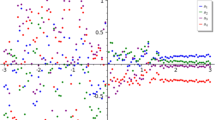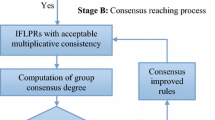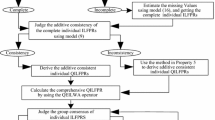Abstract
Preference relations are an efficient technology to derive the priority vectors for the alternatives in group decision-making. In this paper, an analysis of the existing research on group decision-making with intuitionistic fuzzy preference relations (IFPRs) indicates that IFPRs have some desirable properties similar to those in fuzzy situation. Then, generalized intuitionistic fuzzy preference relations (GIFPRs) and their consistency are proposed to model all those desirable properties. The given consistent GIFPRs are completely characterized by intuitionistic fuzzy priority vectors (IFPVs). For inconsistent GIFPRs, the novel \( \delta \)-acceptable consistency and consensus are proposed to preserve the original preference information as much as possible and methods without thresholds seeking to reach the desirable requirements are provided and visualized. Some numerical examples are given to illustrate the proposed models work; and comparisons with the existing methods are also offered to demonstrate the validity, applicability and advantages of the proposed method.






Similar content being viewed by others
References
Atanassov K (1986) Intuitionistic fuzzy set. Fuzzy Sets and Systems 20:87–96
Ahmed F, Kilic K (2019) Fuzzy analytic hierarchy process: A performance analysis of various algorithms. Fuzzy Sets and Systems 362:110–128
Chen SM, Tan JM (1994) Handling multicriteria fuzzy decision-making problems based on vague set theory. Fuzzy Sets and Systems 67:163–172
Chiclana F, Herrera F, Herrera-Viedma E (1998) Integrating three representation models in fuzzy multipurpose decision making based on fuzzy preference relations. Fuzzy Sets and Systems 97:33–48
Chiclana F, Herrera F, Herrera-Viedma E (2001) Integrating multiplicative preference relations in a multipurpose decision-making model based on fuzzy preference relations. Fuzzy Sets and Systems 122:277–291
Chiclana F, Herrera-Viedma E, Alonso S, Herrera F (2009) Cardinal consistency of reciprocal preference relations: a characterization of multiplicative transitivity. IEEE Transactions on Fuzzy Systems 17:14–23
Gau WL, Buehrer DJ (1993) Vague sets. IEEE Transactions on Systems, Man, and Cybernetics 23:610–614
Guo KH (2014) Amount of information and attitudinal based method for ranking Atanassov’s intuitionistic fuzzy values. IEEE Transactions on Fuzzy Systems 22:177–188
Gong Z, Li L, Zhou F, Yao T (2009) Goal programming approaches to obtain the priority vectors from the intuitionistic fuzzy preference relations. Computers & Industrial Engineering 57:1187–1193
Herrera-Viedma E, Chiclana F, Herrera F, Alonso S (2007) Group decision-making model with incomplete fuzzy preference relations based on additive consistency. IEEE Transactions on Systems, Man and Cybernetics, Part B37:176–189
Hong DH, ChoiC H (2000) Multicriteria fuzzy decision-making problems based on vague set theory. Fuzzy Sets and Systems 114:103–113
Jin F, Ni Z, Chen H, Li Y (2016) Approaches to group decision making with intuitionistic fuzzy preference relations based on multiplicative consistency. Knowledge-Based Systems 97:48–59
Li Y, Zhang H, Dong Y (2017) The interactive consensus reaching process with the minimum and uncertain cost in group decision making. Applied Soft Computing 60:202–212
Li C, Dong Y, Xu Y, Chiclana F, Herrera-Viedma E, Herrera F (2019) An overview on managing additive consistency of reciprocal preference elations for consistency-driven decision making and fusion: Taxonomy and future directions. Information Fusion 52:143–156
Liu X, Pan Y, Xu Y, Yu S (2012) Least square completion and inconsistency repair methods for additively consistent fuzzy preference relations. Fuzzy Sets and Systems 198:1–19
Liao HC, Xu ZS (2014) Priorities of intuitionistic fuzzy preference relation based on multiplicative consistency. IEEE Transactions on Fuzzy Systems 22:1669–1681
Liao HC, Xu ZS, Consistency and consensus of intuitionistic duzzy preference relations in group decision making, Imprecision and Uncertainty in Information Representation and Processing, Studies in Fuzziness and Soft Computing 332
Liu JP, Song JM, Chen HY (2019) Group decision making based on DEA cross-efficiency with intuitionistic fuzzy preference relations. Fuzzy Optimization and Decision Making 18:345–370
Liu P, Ali A, Rehman N, Shah SIA (2020) Another view on intuitionistic fuzzy preference relation-based aggregation operators and their Applications. International Journal of Fuzzy Systems 22:1786–1800
Liu F, Tan X, Yang H, Zhao H (2020) Decision making based on intuitionistic fuzzy preference relations with additive approximate consistency. Journal of Intelligent & Fuzzy Systems 39:4041–4058
Ma ZM, Xu ZS (2018) Hyperbolic scales involving appetites-based intuitionistic multiplicative preference relations for group decision making. Information Sciences 451–452:310–325
Ma ZM, Xu ZS, Yang W (2021) Approach to the consistency and consensus of Pythagorean fuzzy preference relations based on their partial orders in group decision making. Journal of Industrial and Management Optimization 17:2615–2638
Meng FY, Tang J, Fujita H (2019) Linguistic intuitionistic fuzzy preference relations and their application to multi-criteria decision making. Information Fusion 46:77–90
Orlovsky SA (1978) Decision-making with a fuzzy preference relation. Fuzzy Sets and Systems 1:155–167
Saaty TL (1980) The Analytic Hierarchy Process. McGraw-Hill, New York, NY
Tanino T (1984) Fuzzy preferenceorderingsingroupdecisionmaking. Fuzzy Sets and Systems 12:117–131
Wan S, Xu G, Dong J (2016) A novel method for group decision making with interval-valued Atanassov intuitionistic fuzzy preference relations. Information Sciences 372:53–71
Wang ZJ (2013) Derivation of intuitionistic fuzzy weights based on intuitionistic fuzzy preference relations. Applied Mathematical Modelling 37:6377–6388
Wang ZJ (2015) Geometric consistency based interval weight elicitation from intuitionistic preference relations using logarithmic least square optimization. Fuzzy Optimization and Decision Making 14:289–310
Wang ZJ (2020) A representable uninorm based intuitionistic fuzzy analytic hierarchy process. IEEE Transactions on Fuzzy Systems 28:2555–2569
Wang H, Xu ZS (2016) Interactive algorithms for improving incomplete linguistic preference relations based on consistency measures. Applied Soft Computing 42:66–79
Wu J, Chiclana F (2014) Multiplicative consistency of intuitionistic reciprocal preference relations and its application to missing values estimation and consensus uilding. Knowledge-Based Systems 71:187–200
Wu J, Chiclana F, Liao H (2018) Isomorphic multiplicative transitivity for intuitionistic and interval-valued fuzzy preference relations and its application in deriving their priority vectors. IEEE Transactions on Fuzzy Systems 26:193–202
Xu ZS (2007) Intuitionistic fuzzy aggregation operators. IEEE Transactions on Fuzzy Systems 15:1179–1187
Xu ZS (2007) Intuitionistic preference relations and their application in group decision making. Information Sciences 177:2363–2379
Xu ZS, Cai XQ, Szmidt E (2011) Algorithms for estimating missing elements of incomplete intuitionistic preference relations. International Journal of Intelligent Systems 26:787–813
Xu Y, Herrera F, Wang HM (2016) A distance-based framework to deal with ordinal and additive inconsistencies for fuzzy reciprocal preference relations. Information Sciences 328:189–205
Xu Y, Herrera F (2019) Visualizing andrectifying different inconsistencies for fuzzyreciprocal preference relations. Fuzzy Sets and Systems 362:85–109
Xia M, Xu ZS, Chen J (2013) Algorithms for improving consistency or consensus of reciprocal \( \left[0,1\right] \)-valued preference relations. Fuzzy Sets and Systems 216:108–133
Xu G, Wan S, Wang F, Dong J, Zeng Y (2016) Mathematical programming methods for consistency and consensus in group decision making with intuitionistic fuzzy preference relations. Knowledge-Based Systems 98:30–43
Yang Y, Wang X, Xu ZS (2019) The multiplicative consistency threshold of intuitionistic fuzzypreference relation. Information Sciences 477:349–368
Yang W, Jhang ST, Shi SG, Xu ZS, Ma ZM (2020) A novel additive consistency for intuitionistic fuzzy preference relations in group decision making. Applied Intelligence 50:4342–4356
Yang W, Jhang ST, Fu ZW, Xu ZS, Ma ZM (2021) A novel method to derive the intuitionistic fuzzy priority vectors from intuitionistic fuzzy preference relations. Soft Computing 25:147–159
Yang W, Jhang ST, Shi SG, Ma ZM, Representable uninorm-based consistencies for intuitionistic fuzzy preference relations in group decision making, submitted to Expert Systems with Applications
Zhang XM, Xu ZS (2012) A new method for ranking intuitionistic fuzzy values and its application in multi-attribute decision making. Fuzzy Optimization and Decision Making 12:135–146
Zhang H (2016) Group decision making based on multiplicative consistent reciprocal preference relations. Fuzzy Sets and Systems 282:31–46
Zhang Y, Xu ZS, Liao H (2017) A consensus process for group decision making with probabilistic linguistic preference relations. Information Sciences 414:260–275
Zhang HJ, Li CC, Liu YT, Dong YC (2021) Modelling personalized individual semantics and consensus in comparative linguistic expression preference relations with self-confidence: An optimization-based approach. IEEE Transactions on Fuzzy Systems 29:627–640
Acknowledgements
The authors would like to thank the editors and the anonymous reviewers for their insightful and constructive comments and suggestions that have led to this improved version of the paper. This research was supported by the National Research Foundation of Korea funded by the Ministry of Education under Grant NRF-2021R1A2C1095739 and the Natural Science Foundation of Shandong Province (Grant No. ZR2017MG027).
Author information
Authors and Affiliations
Corresponding author
Ethics declarations
Conflicts of interest
The authors declare that they have no conflict of interest.
Additional information
Publisher’s Note
Springer Nature remains neutral with regard to jurisdictional claims in published maps and institutional affiliations.
Rights and permissions
About this article
Cite this article
Xie, H.T., Ma, Z.M., Xu, Z.S. et al. Novel consistency and consensus of generalized intuitionistic fuzzy preference relations with application in group decision making. Appl Intell 52, 16832–16851 (2022). https://doi.org/10.1007/s10489-021-03081-z
Accepted:
Published:
Issue Date:
DOI: https://doi.org/10.1007/s10489-021-03081-z




